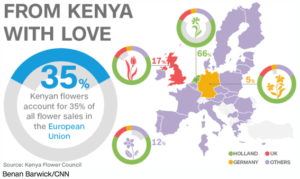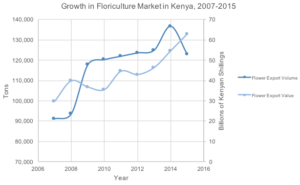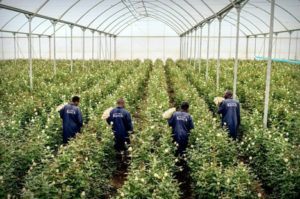In Kenya, roses are red but the flower industry is blue over climate change

Facing increasing pressure from domestic actors and its Dutch distributors, the Kenya Flower Council must adapt quickly to climate change-related challenges to maintain market share in Europe.
Risks and ramifications of climate change are particularly acute in vulnerable industries in developing countries, but the consequences can have unexpected global reach. Kenya’s floriculture industry, represented by the Kenya Flower Council (KFC), currently produces 35% of all flowers sold in the European Union [1]. Should the KFC fail to adapt to current challenges, abundant Valentine’s Day bouquets may become a thing of the past.
A high-growth industry, but is it all coming up roses?
The KFC is a voluntary association that includes the majority of Kenya’s independent growers and exporters of cut flowers [2]. Significant investment in technology, precision farming, marketing, and human capital has allowed KFC firms to achieve impressive growth, as Kenya’s flower exports increased by 1,200% between 1988-2014 [3]. In 2015, export volumes reached 122,000 tons at an estimated value of 62.9 billion Kenyan shillings ($620M USD), which accounted for 1.01% of Kenya’s GDP [4,5]. The industry directly employs 500,000 people, a significant part of the population [6].
Despite this growth, the KFC faces significant obstacles related to climate change that threaten the efficiency of flower production and the industry’s supply chain. Effects of decades of below-average rainfall in East Africa are exacerbated by Kenya’s limited freshwater supply [7,8]. Flower production is water-intensive, so dwindling resources put pressure on farms’ operating models. Furthermore, drought and population growth in primary growing regions have resulted in increased conflict between KFC member farms and local communities that have ancestral claims to land and water resources. [9]
Distribution occurs via daily air cargo transportation from Nairobi to Amsterdam, which presents sustainability concerns. According to a 2007 study, the carbon footprint of flying flowers from Kenya is six times smaller than producing flowers in the Netherlands, but transporting flowers from Kenya to Europe still requires significant fuel consumption [10,11]. This distribution model often results in reduced flower quality – primarily due to temperature fluctuations among the farms, flights, and arrival conditions – but the speed of air cargo has historically made this model essential given the short shelf-life of flowers.
Not resting on its laurels
In response to water scarcity issues, the KFC has taken two critical steps. First, the association partnered with the World Wild Fund to establish enabling conditions, including strengthened regulation, for more sustainable management of the Lake Naivasha Basin, the region responsible for 95% of Kenya’s cut flower exports [13]. Secondly, the KFC worked across sectors with Camco Advisory Services, a regional firm focused on clean energy solutions, and the Horticultural Crops Development Authority to develop a Carbon Reduction, Resources, and Opportunities Toolkit (CaRROT). This accounting and management solution allows the KFC to measure greenhouse gas emissions, energy efficiency, and water consumption to target opportunities to improve its production efficiency [14].
With respect to distribution, Kenyan firms and Royal FloraHolland have experimented with refrigerated ocean containers as a less expensive, more environmentally-friendly cold chain alternative to air cargo under an initiative called Flowers@Sea. According to officials at Royal FloraHolland – the Wall Street for Flowers – the transition from air to ocean freight could reduce costs by 38% and cut greenhouse gas emissions by 87% [15]. Furthermore, ocean transport allows for tightly controlled temperature management, which improves flower quality. One downside is increased lead time, as seaborne journeys between Africa and Europe take 28-30 days [16].
Next steps for the KFC
Flowers are price-elastic goods, so poor global economic conditions can dramatically affect demand, and certain production costs within Kenya may continue to rise due to inflation and other factors [17]. To further mitigate risks associated with climate change and maintain demand, the KFC could consider the following actions:
- Improve producers’ forecasting capacity: The cost to ship flowers from Kenya to Europe averages $2.00/ kilogram by air but only $1.20/ kilogram by sea [18]. Reduced costs are a plus, but increased ocean transport means firms must adjust to longer lags in the supply chain. The KFC should develop a solution similar to CaRROT that helps farms forecast demand from channel partners.
- Direct savings toward domestic cold chain infrastructure: Distribution will increasingly shift from Nairobi’s airport to the coastal city of Mombasa. While the state of the country’s roads presents overland transportation challenges, the KFC could invest savings generated from reduced air cargo in cold chain infrastructure to improve quality control within the domestic supply chain.
- Market eco-friendliness: Anticipating that European consumers will increasingly care about the environmental impact of their purchases, the KFC could negotiate with mass market retailers to ensure their flowers are labeled “eco-friendly” to increase demand for Kenyan exports.
[781 words]
Sources
[1] Milena Veselinovic, “Got roses this Valentine’s Day? They probably came from Kenya,” CNN, March 16, 2015, http://www.cnn.com/2015/03/16/africa/kenya-flower-industry/, accessed November 3, 2016.
[2] “KFC Profile,” Kenya Flower Council, 2016, http://kenyaflowercouncil.org/, accessed November 2, 2016.
[3] Neil Ford, “A Time of Change for Agribusiness,” African Business (September 2016): 13.
[4] Shadrack Kavilu, “Kenya’s flourishing flower sector is not all roses for Masaai herdsmen,” Reuters, June 30, 2016, http://www.reuters.com/article/us-kenya-landrights-idUSKCN0ZG0Z0, accessed November 2, 2016.
[5] “Floriculture in Kenya,” Kenya Flower Council, 2016, http://kenyaflowercouncil.org/?page_id=92, accessed November 2, 2016.
[6] Ibid.
[7] I. Niang, O. Ruppel, M.A. Abdrabo, A. Essel, C. Lennerd, J. Padgham, and P. Urquhart, “Africa,” Climate Change 2014: Impacts, Adaptation, and Vulnerability, Part B: Regional Aspects, Contribution of Working Group II to the Fifth Assessment Report of the Intergovernmental Panel on Climate Change, Cambridge University Press, Cambridge, UK, 1207.
[8] Kenya Country Risk Report Q4 2016, BMI Research, October 2016, London, UK, 35.
[9] Kavilu, “Kenya’s flourishing.”
[10] David Bosomworth, “Shades of green,” Supply Management 15(10), 2010, 17.
[11] Ibid.
[12] Vanessa Thevasthasan, “Kenya’s Peace Blooms: The Intersection of Water, Land, Power and People,” Huffington Post, February 18, 2015, http://www.huffingtonpost.com/vanessa-thevathasan/kenyas-peace-blooms-the-i_b_6691816.html, accessed November 3, 2016.
[13] “IWRAP,” Kenya Flower Council, 2016, http://kenyaflowercouncil.org/?page_id=750, accessed November 2, 2016.
[14] “CaRROT,” Kenya Flower Council, 2016, http://kenyaflowercouncil.org/?page_id=745, accessed November 2, 2016.
[15] Reynolds Hutchins, “Flower shippers latest to test maritime cold chain,” Journal of Commerce, October 15, 2016.
[16] Martin Rivers, “Cold chain in focus as floriculture heats up,” African Business 418 (April 2015): 36.
[17] Rivers, “Cold chain,” 36.
[18] Rivers, “Cold chain,” 39.






This article clearly changed my view on the production of flowers sold in the European Union. I could never believe that flowers are brought by air to the European continent. Why do the Netherlands have such a high carbon footprint so that producing and flying flowers from Kenya has even less climate consequences? What do they actually do wrong? My question is also how the Kenyan flower industry has actually evolved so that shipping/flowers to Europe was a logical step? Isn’t this absolutely illogical based on the constraints of fresh water supply? Weren’t there any other possibilities of producing something that could be sold inside of Kenya or to some of their neighbor states? Is the procurement power in Europe so much bigger that it is profitable to send the flowers from Kenya to Europe? Would people still be so happy about getting roses, if they knew where they are actually from? Does that not contradict their actual meaning? For almost my entire life I picked flowers in my mother’s garden in order to make a person, I like or love a little gift. But isn’t it too big now to give flowers from Kenya? I am confused.
Very interesting article and much like Christine above- I’m quite surprised at a lot of facts. Particularly, I find it very surprising that growing the flowers in Kenya and air shipping them has a lower carbon footprint than just growing them in the Netherlands. How is that possible? Does the KFC have a very efficient flower growing process that the Dutch do not have?
As a florist by hobby, I enjoyed reading this article very much. As we discussed during Indigo case, agriculture–which includes floriculture in broad sense–does seem to be one of the industries that are heavily impacted by climate challenge. But to the point in the article that flowers are not necessities and thus have high price elasticity, I wonder if the investment going into innovations in growing and transporting flowers is significantly less. Does the Kenya Flower Council have sufficient funds to account for all the research and development efforts needed to come up with a better solution? If not, as in the case of Indigo, can it prove opportunities for further innovation and subsequent profitability improvements in floriculture and involve outside investors?
Thanks, Brittany – this was a fascinating read! With respect to economics questions raised above, you might find this Financial Times (2015) article helpful: https://www.ft.com/content/4839da78-b8fa-11e4-a8d0-00144feab7de. It tells us that despite the vast distances, Kenya benefits from low cost of labor, abundant workforce (growing, picking and pruning roses is indeed labor-intensive), equatorial temperatures more conducive to year-round growing (without need for expensive glasshouse heating) and better lighting – thereby contributing more flowers to Europe than one of its own, the Netherlands. Given socioeconomic potential of this industry, I agree we should focus on this debate on ways to reduce carbon footprint and improve the KFC’s forecasting and shipping capacities, rather than meeting demand elsewhere. Can the KFC adopt low-cost cold chain technologies already on the U.S. market to this aim? I’d like to see them work with existing “connected transportation” vendors like Locus Traxx (Emerson), Orbcomm and Numerex that offer cheap ($2-3 per device) hardware/sensors and related software platform enabling real-time location and temperature monitoring of perishable goods, so that they can transition faster to shipping by ocean containers.
Great blog post, Brittany! What fascinates me most about this issue is the clear dichotomy between producing a good in a low-cost environment and the potential benefits this may have for the consumer versus the incredible cost of transport and logistics to reach the end-consumer. In this case, I would imagine that a significant portion of the cost could be passed on to the consumer if transport cost (through fuel cost, for example) were to rise or if supply were to decline drastically due to water shortage issues. In both cases, prices would go up substantially, thus directly impacting consumers.
A few years ago, I was watching a documentary, which also referenced the flower industry in Kenya and the trade with Amsterdam. Another interesting aspect of this supply chain was the incredible amount of waste produced when flowers wilt or get damaged in the transportation process. I wonder if the industry has taken any steps since then to reduce waste and ensure more flowers reach the destination. By doing so, we implicitly increase supply and improve efficiency of production.
This article is absolutely fascinating – I would have absolutely never guessed that Kenya supplied so much of the EU’s flowers and, almost more shockingly, that flying flowers all the way from Africa has such a dramatically smaller impact on carbon emissions than producing flowers in Amsterdam!
Interestingly, I came across an article (below) which begs the same question about roses (~80% of roses found in the U.S. apparently come from South America); I clearly didn’t appreciate the size of the import market for flowers. I wonder if there is some way in which growers from all over the world could promote and institute “best-practices” for growing so as to most drastically reduce the impact of emissions to the carbon footprint of the flower industry altogether. The author makes the argument that oftentimes flowers grown in the U.S. are so much worse for the environment simply because they are grown in climate-controlled greenhouses. Is there a more carbon-conscious way to economically produce fresh flowers domestically? Or should we instead be focused on growing these flowers solely in Africa and South America (where growers can rely on natural sunlight, as opposed to artificial heating and lighting, resulting in a much lower negative carbon impact), and shift our attention to being able to transport these products in a more carbon-friendly way?
https://www.scientificamerican.com/article/environmental-price-of-flowers/
Super interesting post! Same as the posters above- I would never have guessed the Netherlands gets flowers from Kenya! I am interested in the regulations around the labeling of these flowers. I liked your suggestion about marketing eco-friendliness and I would perhaps even take it further it suggest creating some sort of label like we have around other consumer goods so that consumers are more aware of where the flowers they are purchasing are coming from and what the environmental impact of that purchase has.
Nice article! Thank you for sharing! This is a great example of a conflicting supply chain. You can either reduce the amount of fuel used by choosing a more sustainable and environmentally friendly mode of transportation, thus resulting in an increased lead time and poor quality product, or you can choose a more practical mode of transport and have your product arrive fresh. So what’s the solution? I know chemical industries have products that help keep fruits and vegetables fresh longer. I wonder if there is a safe chemical that can be applied to plants to help increase the lifespan.